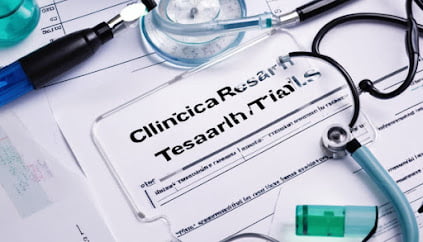What is Clinical Research & Clinical Trials?
Clinical research is a specialized field within medical science dedicated to examining the safety and efficacy of medications, devices, diagnostic products, and treatment plans designed for human use. It plays a pivotal role in advancing medical knowledge, enhancing patient care, and fostering the development of innovative therapies and interventions. BA & BE study.
The following are key elements of clinical research:
Phases of Clinical Trials:Clinical research
- Phase I: Involves initial testing in a small group of healthy volunteers to assess safety and determine appropriate dosage.
- Phase II: Encompasses a larger group of patients to evaluate efficacy and delve deeper into safety considerations.
- Phase III: Entails large-scale trials to confirm effectiveness, monitor side effects, and compare the new treatment to standard therapies.
- Phase IV: Comprises post-marketing studies conducted after treatment approval to gather additional information on safety, efficacy, and optimal usage.
Clinical Trial Process
Protocol Development: Researchers formulate a detailed plan (protocol) outlining the study’s objectives, methodology, and criteria for participant eligibility.
Informed Consent: Participants are informed about the study and provide voluntary consent to participate.
Recruitment: Researchers enroll eligible participants based on specific criteria.
Intervention: Participants receive the investigational treatment or intervention.
Data Collection: Involves systematic gathering of data on participants’ health outcomes.
Analysis: Statistical analysis is conducted to assess the safety and efficacy of the treatment.
Reporting: Results are disseminated through scientific publications, conferences, and regulatory submissions.
Regulatory Oversight: Regulatory agencies, such as the U.S. Food and Drug Administration (FDA) and the European Medicines Agency (EMA), oversee and approve clinical trials to ensure participant safety and data integrity.
Ethical Considerations: Ethical review boards or institutional review boards (IRBs) evaluate the ethical aspects of a study, safeguarding the well-being and rights of participants.
Collaboration: Clinical research involves collaboration among researchers, healthcare professionals, regulatory agencies, sponsors (often pharmaceutical companies), and participants.
Translational Research: Aims to translate basic scientific discoveries into practical applications, enhancing patient care and outcomes.
Patient-Centered Outcomes Research: Prioritizes incorporating patient perspectives in the research process to address questions that are most relevant to patients.
Clinical Trial Design: Researchers meticulously craft the design of clinical trials to effectively address specific research questions. This involves making decisions about the study population, selecting suitable control groups, defining outcome measures, and determining the trial’s duration.
Randomized Controlled Trials (RCTs): Considered the benchmark in clinical research, RCTs randomly assign participants to either the experimental group (receiving the new treatment) or the control group (receiving standard treatment or a placebo). Randomization serves to minimize bias, ensuring an even distribution of both known and unknown factors between the groups.
Endpoints and Outcomes: Clinical trials utilize predefined endpoints or outcomes to gauge the intervention’s effectiveness. These can be clinical (e.g., reduction in symptoms), surrogate (e.g., a laboratory test), or patient-reported outcomes. Primary endpoints represent the main outcomes of interest, while secondary endpoints offer additional information.
Monitoring and Data Safety: Independent Data Monitoring Committees (DMCs) oversee participant safety during clinical trials, reviewing interim data and recommending modifications or early termination in case of safety concerns. Data and Safety Monitoring Boards (DSMBs) also play a role in large-scale trials.
Good Clinical Practice (GCP):Clinical research
GCP constitutes a set of international ethical and scientific quality standards that guarantee the proper design, conduct, recording, and reporting of clinical trials. Adhering to GCP guidelines is crucial to maintaining data integrity and safeguarding the rights and well-being of study participants.
Regulatory Submissions: Before commencing a clinical trial, researchers must submit a comprehensive protocol to regulatory agencies for approval. This submission includes information on study design, participant selection, informed consent procedures, and the data analysis plan. Regulatory agencies, such as the FDA or EMA, conduct inspections to ensure compliance with regulations.
Data Analysis and Reporting: Statistical analysis is a pivotal aspect of clinical research, assisting in determining the significance of observed effects. Transparent reporting of results, whether positive or negative, is indispensable for the scientific community and healthcare decision-makers.
Post-Marketing Surveillance: Following the approval and market entry of a treatment, post-marketing surveillance persists to monitor its safety and effectiveness in larger patient populations.
International Collaboration: Clinical research frequently entails collaboration among researchers from various countries. Multinational trials enhance result generalizability and enable a more diverse participant pool.
Emerging Trends: The integration of technological advancements, such as electronic health records and wearable devices, is becoming more prevalent in clinical research. This integration streamlines data collection and participant monitoring processes.
Challenges: Clinical research encounters obstacles like recruitment difficulties, ethical considerations, and the necessity for long-term follow-up data. Effectively addressing these challenges is imperative for the successful execution of trials.
Patient Engagement: The significance of involving patients in the research process is growing. Patient engagement ensures that research inquiries align with patient priorities and facilitates the effective dissemination of trial results within the patient community.
Clinical Research Significance: Critical for medical progress, clinical research contributes to the development of new treatments, preventive measures, and a deeper understanding of various diseases. It mandates rigorous scientific methodology, ethical standards, and collaboration across diverse disciplines.
Clinical Study Report (CSR):Clinical research
A comprehensive document, the CSR summarizes the design, methods, results, and conclusions of a clinical trial. Typically, it comprises sections like:
Title and Synopsis:
Clearly articulates the study’s purpose and provides a concise overview.
Study Design:
Details the trial’s structure, randomization, blinding, and methodology.
Participants:
Elaborates on inclusion/exclusion criteria, demographics, and baseline characteristics.
Interventions:
Specifies the treatments administered, dosages, and any comparators used.
Objectives:
Enumerates primary and secondary endpoints for assessing the study’s success.
Methods:
Elaborates on procedures, data collection, and statistical analyses employed.
Results:
Presents numerical and statistical outcomes, including adverse events.
Discussion:
Analyzes findings, addresses limitations, and compares results with existing literature.
Conclusion:
Summarizes key findings and their implications for clinical practice.
Safety and Adverse Events:
Provides details on safety measures, adverse events, and steps taken to ensure participant well-being.
Ethical Considerations:
Discusses ethical approvals, informed consent, and adherence to regulatory standards.
References:
Includes citations for all sources used in the CSR.
Appendices:
Incorporates additional data, charts, or supplementary information.
Acknowledgments:
Recognizes contributors and funding sources.
A well-organized CSR is pivotal for regulatory submissions, ensuring transparency and integrity in reporting clinical trial results. Adhering to international standards, such as the ICH E3 guidelines, is crucial for facilitating the regulatory review process and fostering scientific understanding.
Method validation Report:
Validation of a method constitutes a pivotal stage in guaranteeing the dependability and precision of analytical methods employed for substances, such as drugs in plasma analysis. The following are key parameters routinely considered in the validation process for plasma analysis:
Specificity:
Verifies the method’s capability to distinguish and precisely measure the target analyte amidst other components in plasma, preventing interference.
Accuracy:
Validates the proximity of measured values to true values, often assessed through recovery studies comparing known concentrations with measured ones.
Precision:
Evaluates the method’s reproducibility and repeatability. Intra-day precision assesses variation within a day, while inter-day precision assesses variation across different days.
Linearity:
Demonstrates the method’s capacity to yield results directly proportional to the analyte concentration in the sample within a defined range.
Range:
Specifies the concentration range over which the method is validated to provide accurate and precise results.
Limit of Detection (LOD) and Limit of Quantitation (LOQ):
LOD represents the lowest reliably detectable analyte concentration, while LOQ is the lowest concentration quantifiable with acceptable precision and accuracy.
Robustness:
Assesses the method’s reliability under slight variations in parameters like pH, temperature, or mobile phase composition.
Selectivity:
Ensures the method’s capability to differentiate the analyte from other components, including potential metabolites or matrix effects in plasma.
Matrix Effect:
Evaluates the impact of plasma components on the method’s accuracy and precision by comparing responses in the presence and absence of plasma.
Stability:
Examines the stability of the analyte in plasma during sample storage and handling, addressing concerns such as freeze-thaw stability, short-term, and long-term stability.
Carryover:
Checks for any residue from previous samples that might affect subsequent measurements, potentially leading to inaccuracies.
Recovery:
Measures the method’s ability to accurately extract the analyte from plasma, often assessed by comparing the concentrations of spiked samples before and after extraction.
Ensuring a robust method validation is indispensable for generating dependable data in pharmacokinetic studies, therapeutic drug monitoring, and other applications where precise measurement of drug concentrations in plasma is imperative.
Conclusions:
In conclusion, the meticulous validation of analytical methods for plasma analysis is paramount to ensuring the integrity and accuracy of results, particularly in the assessment of substances like drugs. Through a comprehensive evaluation of parameters such as specificity, accuracy, precision, linearity, range, limit of detection, limit of quantitation, robustness, selectivity, matrix effect, stability, carryover, and recovery, a validated method attains a level of reliability essential for various applications.
The specificity of the method guarantees its ability to discern and accurately quantify the target analyte amidst complex plasma components, avoiding any potential interference. Accuracy, assessed through recovery studies, validates the closeness of measured values to true values, establishing the method’s trustworthiness. Precision, whether intra-day or inter-day, examines the method’s consistency and reproducibility over different time frames.
Linearity and range showcase the method’s capability to produce proportional results within defined concentration ranges, ensuring its applicability to diverse scenarios. Limits of detection and quantitation define the method’s sensitivity and lower boundaries for accurate quantification. Robustness ensures the method’s resilience to minor variations, enhancing its reliability under different conditions.
Selectivity evaluates the method’s ability to distinguish the analyte from other components, while the matrix effect considers the impact of plasma constituents on accuracy and precision. Stability assessments address potential issues during sample storage, including freeze-thaw stability, short-term, and long-term stability.
Carryover examinations prevent inaccuracies caused by residue from previous samples, maintaining the method’s precision. Recovery studies assess the method’s effectiveness in accurately extracting the analyte from plasma, further validating its suitability for intended applications.
In essence, a robustly validated method forms the foundation for generating dependable data in critical fields such as pharmacokinetic studies and therapeutic drug monitoring. The thorough consideration of these validation parameters ensures that the method reliably and accurately measures drug concentrations in plasma, fulfilling the stringent requirements of scientific research and clinical applications.





My programmer is trying to convince me to move to .net from PHP. I have always disliked the idea because of the costs. But he’s tryiong none the less. I’ve been using Movable-type on a variety of websites for about a year and am anxious about switching to another platform. I have heard fantastic things about blogengine.net. Is there a way I can import all my wordpress posts into it? Any help would be greatly appreciated!
You are a very smart individual!
Wow! This could be one particular of the most helpful blogs We have ever arrive across on this subject. Basically Great. I am also an expert in this topic so I can understand your hard work.